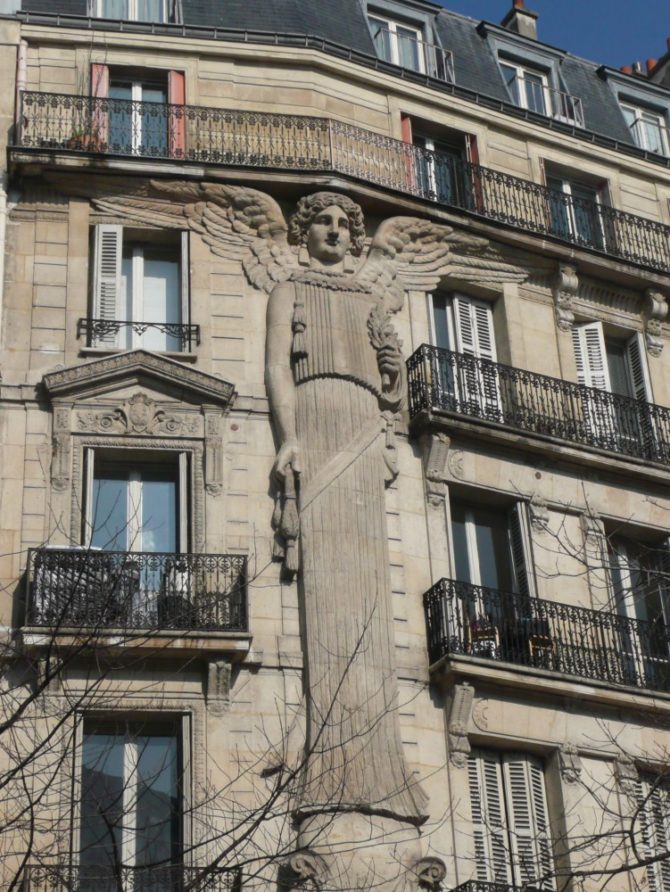The Angel of the Rue de Turbigo

Spanning three stories of an apartment building at 57 rue de Turbigo, the colossal, smiling stone angel surveys the human comedy of Paris unfolding at its feet. With massive wings unfurled like a modern Winged Victory, its feathers brush against the fourth-floor windows of the building, designed by architect Eugène Demangeat in 1860.
Demangeat was a key player in the 19th-century demolition-and-building boom in Paris orchestrated by Georges Eugène Haussmann, known as Baron Haussmann, under the aegis of Napoleon III. The goal was to aerate, beautify and unify the city, much of which had remained, until then, a medieval maze of dark, insalubrious winding streets.
The rue de Turbigo, extended beyond the rue Saint Martin by an 1858 decree, cuts a diagonal axis across the city’s Right Bank, stretching from Les Halles in the 1st arrondissement to the Place de la République in the 10th. The name celebrates a French victory over the Austrian army in the town of Turbigo, in northern Italy, in 1859.
Aged 43 and in his prime, Demangeat had already been awarded contracts for three similar buildings in the lower end of the street. Those buildings, with flat facades in alignment with surrounding structures, neither required nor received any particular ornamentation. But the rue de Turbigo bends gently in an oblique angle, precisely at number 57, confronting the architect with an aesthetic challenge: how to accentuate and soften the corner with a pleasing visual hook?
A budding architect had an interesting project to propose…. In 1852, as a second-year student at the Ecole des Beaux-Arts et Architecture, Emile-August Delange had participated in a competition to design a lighthouse. His proposal featured a giant angel—a reference to his own name?— towering over the lighthouse lantern, to guide sailors safely over rocky seas. His design, with its fussy base of mini-pyramids, was an allusion to the great lighthouse of Alexandria. It lost the contest, but won the attention of César Daly, editor of the prestigious professional journal Revue Générale de l’Architecture et Travaux Publics.
Daly chose Delange’s drawing, along with those of three other students, to be engraved and featured in his publication. He lauded these projects for their poetic artistry amid an “ocean of materialism”. Daly’s influence cannot be underestimated: it would resound much later, in the 20th century, when Frank Lloyd Wright revived Daly’s concept of “organic architecture”.
Delange’s thirty-foot angel was indeed poetic, and its slightly revised version, eight years later, fit with organic aplomb on Demangeat’s new building. The angel’s long gown, finely pleated like the fluting of a Corinthian column, gracefully rounds off the corner angle, while its enormous outstretched wings hide the support system of the fourth floor balcony. Even more fortuitously, the angel’s fancy adornments—bead necklace, long ribbon sash, tasseled earrings, gown and bag—most of them already present on the original drawing, made it a heavenly mascot for a nearby neighborhood’s primary industry: the rue de Turbigo is not far from the Sentier, the garment and trimmings district of Paris.
The passementerie, or decorative textile trimmings industry, established as a profession under Louis XIV, enjoyed a renaissance in the mid-19th century, reflecting the opulence and prosperity of the Second Empire. Pompoms, tassels, fringes and braiding embellished women’s apparel, military uniforms and interior decorating—the Napoleon III apartments in the Richelieu wing of the Louvre bear witness to the
extravagance of the times. The eclectic trend is embodied in the angel’s neo-Grecian profile and Renaissance-style hairdo.
In its right hand, the angel holds a bourse, a long tasseled bag of elusive meaning. Could it be a sacred reference to charity, a virtue of any self-respecting angel? Or rather the profane attribute of Mercury, the god of commerce? It’s all left to conjecture, as no records have been found of the commission of Delange’s angel for the building.
The rue de Turbigo runs through the Saint Martin district, not an aristocratic area like the Marais several blocks away; with few exceptions it is bereft of grand hôtels particuliers, or private mansions, but it was a bastion of beautiful apartment homes to rent, in buildings known as palais collectifs. Early residents of the luxurious upper floors of no. 57 included the fashion gentry of the times: a textile trader, a tie wholesaler, jeweler, corset-maker and milliner. Their upscale dwellings were graced with an antechamber, dining room, salon and three bedrooms complete with fireplaces.
The building is identified in records and bills of sale as the Maison du Génie, génie being, among its several meanings, a term for any angel or allegorical figure used in a civic setting. In spite of its fancy components, the angel carefully respects the strict Haussmannian building codes, which forbade the use of projecting elements. Its unfurled wings are tucked under the fourth floor balcony, its body flush with the wrought-iron grillwork, without obstructing the passage of light into the 90-window building.
At its post for more than 150 years, the angel of the rue de Turbigo continues to radiate its eccentric charm.
57 rue de Turbigo, 3rd, Métro: Arts et Métiers
Rosemary Flannery is an American living in Paris. Her book, Angels of Paris: An Architectural Tour Through the History of Paris, was published by The Little Bookroom in November 2012. 228 pages. $18.95.
Originally published in the April 2011 issue of France Today; updated in December 2012
Share to: Facebook Twitter LinkedIn Email



